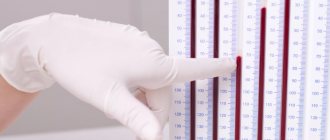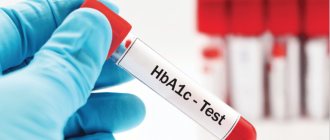Determining blood glucose levels will help identify several serious diseases at an early stage.
This is especially true when it comes to young children who cannot report illnesses on their own.
Remember, the earlier the disease was noticed, the easier it is to cure it.
Indications for the study
There are no specific indications for the study. The main reason why parents may take their child to see a doctor is suspicion of diabetes.
The main symptoms that can alert family members include:

- change in habitual appetite, sudden change in mood;
- child's passion for eating sweets. High need for sugar;
- constant thirst;
- weight change, most often weight loss;
- frequent and copious trips to the toilet.
If at least a few points are detected, a blood test should be taken.
You should limit your sugar intake by replacing products of this type with healthier analogues: fruits and berries.
In what cases is a glucose test usually prescribed?
Typically, glucose levels are determined when a carbohydrate metabolism disorder is suspected. The most common cause of chronic high blood glucose (hyperglycemia) is diabetes mellitus. It is important to check fasting glucose during clinical examination for healthy people, since diabetes can be asymptomatic for several years and is diagnosed already at the stage of complications.
A glucose test (otherwise called “blood sugar”) is used to screen healthy individuals, to identify patients with prediabetes and diabetes, and when examining pregnant women.
Low glucose levels (hypoglycemia) can be life-threatening, and acute hypoglycemia can lead to coma and death of brain cells.
Several sequential blood glucose measurements are taken during a glucose tolerance test. In this case, the patient is first measured on an empty stomach, and then given a so-called “sugar load”, after which the glucose level is measured after 1 and 2 hours. The glucose tolerance test (OGTT) is not performed in medical laboratory offices because the patient must be under the supervision of a physician while performing the test. The OGTT (oral glucose tolerance test) can only be done in patients whose fasting glucose level does not exceed 7 mmol/l.
How to prepare for a glucose test?
Basic preparation consists of following the basic rules:
- the child must donate blood on an empty stomach;
- It is not advisable to brush your teeth in the morning, since any toothpaste contains sugar, while glucose is absorbed in the oral cavity. Such an action may affect the final result of the audit;
- The child is allowed to drink water. Such relaxation will dull the feeling of hunger and calm the child a little.
It is recommended to engage in psychological preparation of the child for the procedure.
It is good if one of the parents is present in the office during the blood donation.
It is not recommended to give your child juice or tea before the procedure.
How to donate blood for sugar testing for a child?
There are two main methods for taking a blood sugar test:
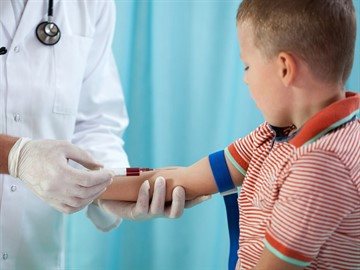
- from the finger . The least painless option for the baby. The results may have a slight error. If, after donating blood, parents doubt the results, you can resort to the second method;
- from a vein . The most accurate option, capable of determining blood sugar levels with virtually no errors. In this case, it is necessary to prepare for the procedure in the same way as when donating blood from a finger prick.
The doctor may not accept the patient if he is in the acute stage of the disease. If the child has a cold, then it is necessary to postpone such procedures.
In the days before donating blood, it is necessary for the baby to follow his usual diet. Prolonged hunger or overeating before the procedure also affects the accuracy of the result.
Rules for using a glucometer
To ensure accurate glucometer readings, it is important to follow certain rules.
Calibration
Most blood glucose meters require you to calibrate the device before taking a measurement. Don't neglect this procedure. Otherwise, the received data will be incorrect. The patient will have a distorted picture of the course of the disease. Calibration takes just minutes. Details of its implementation are described in the instructions for the device.
Measurement three times a day
Blood sugar measurements should be taken before meals, after meals and before bed. If the analysis must be done on an empty stomach, then the last snack is acceptable 14–15 hours before the procedure. For type 2 diabetes, it is recommended to take measurements several times a week. But insulin-dependent diabetics (type 1) should monitor glycemia several times a day. However, one should not lose sight of the fact that taking medications and acute infectious diseases can affect the data obtained.
Monitoring indicators
If inconsistencies are noted in the device readings, it is necessary to re-test. Results may be affected by insufficient blood from the puncture site and unsuitable test strips. To eliminate the first reason, it is recommended to wash your hands in warm water before the analysis. After the puncture, the finger should be lightly massaged. Do not squeeze out blood under any circumstances.
Expiration date of consumables
Before using test strips, be sure to make sure that they are within their expiration date and have been stored under favorable conditions: in a dry place, protected from light and moisture. Do not touch them with wet hands. Before testing, make sure that the code on the device screen matches the numbers on the test strip packaging.
Correct operation
To extend the life of your glucometer, monitor its condition: clean the device on time, change lancets. Dust particles may negatively affect the measurement results. If there are several diabetics in the family, each should have an individual meter.
How to properly test children at 1 year old?
Children aged one year have additional recommendations for preparing and taking the test.

Thus, the main preparatory measures include:
- It is prohibited to feed a baby with breast milk for ten hours;
- It is also prohibited to take other food in the form of cereals or juices during the same time;
- It is necessary to monitor the child’s activity. Before the procedure, it is recommended to reduce active games. The baby should be calm and sedentary.
The results obtained require additional confirmation after a certain time. Most often, such procedures are carried out once every few years.
Doctors cannot take blood from one-year-old children from places familiar to adults. That is why heels or big toes are alternative sources. In addition, this option is safer and painless.
Acceptable sugar levels
For each age, there are separate standards that the doctor and parent should focus on.
All indicators are presented in the unit of measurement mmol/l:

- children aged one year. The norm is considered to be indicators not exceeding 4.4 units;
- children aged from one year to five years must have indicators no higher than 5 units;
- Blood sugar in children over five years of age should not exceed 6.1 units.
If the indicators exceed the norm, the child must take a second test, observing all the necessary preparation requirements.
Suspicion may be caused by tests in which sugar levels are significantly lower than the prescribed norm. It can also be a sign of a serious illness.
Blood sugar levels for diabetes
Normal blood sugar readings on a glucometer depend entirely on how much insulin the body produces. Insulin is a hormone produced by the pancreas. The task of the hormone is to control the level of sugar entering the cells of the organs.
It happens that the pancreas does not produce enough insulin or the hormone is no longer able to interact with cells. As a result, hyperglycemia occurs.
Hyperglycemia is a chronic increase in blood sugar levels, which results in diabetes mellitus.
Insulin is responsible for moving glucose from the blood to the organs. In a healthy body, this process proceeds without complaints or obstacles. In a sick person, glucose is not transported to the organs, due to which it continues to be produced and remains in the blood. When the blood becomes oversaturated, it thickens. In this regard, there are difficulties in saturating the organs with oxygen and other nutrients.

One way to suspect the disease is through characteristic symptoms:
- 24/7 thirst
- dry mouth,
- frequent urination,
- weakness throughout the body,
- vision weakens,
- feeling hungry, even after eating.
A more dangerous condition is when glucose levels rise sharply after eating. Under such circumstances, a person is accompanied by symptoms:
- wounds that do not heal for a long time,
- desire to eat, even on a full stomach,
- suppuration on the skin,
- Gums begin to bleed
- weakness in the body,
- reduced performance.
A person remains in this state for up to several years and has no idea that he is sick.
More than 50% of people are unaware that they already have type 2 diabetes.
- Methods for determining blood sugar at home - with and without a glucometer
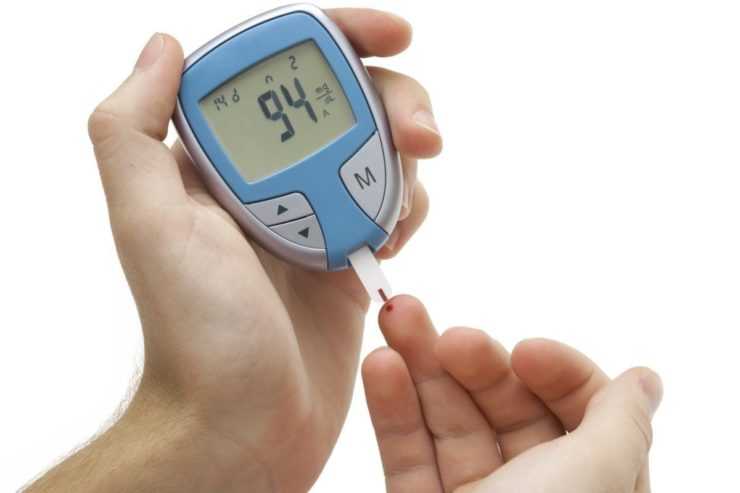
One way to suspect the disease is through characteristic symptoms:
- 24/7 thirst
- dry mouth,
- frequent urination,
- weakness throughout the body,
- vision weakens,
- feeling hungry, even after eating.
A more dangerous condition is when glucose levels rise sharply after eating. Under such circumstances, a person is accompanied by symptoms:
- wounds that do not heal for a long time,
- desire to eat, even on a full stomach,
- suppuration on the skin,
- Gums begin to bleed
- weakness in the body,
- reduced performance.
A person remains in this state for up to several years and has no idea that he is sick.
More than 50% of people are unaware that they already have type 2 diabetes.
This happens because most patients do not pay attention to symptoms that indicate the development of pathology in the body. To avoid complications, it is recommended to regularly check your blood sugar levels with a glucometer.
By age
Regardless of gender, there are normal values for each age category. The indicator is expressed in mmol/l.
Jumps in glucose are also associated with menopause or an interesting position of a woman.
An important point in the procedure is blood sampling. To obtain an accurate result, it is recommended to follow the following recommendations:
- How is blood sugar measured: units and designations
- come for the test in the morning, on an empty stomach,
- after the last meal, a period of 8 hours or more must pass,
- eliminate stressful situations,
- 2-3 days before the test, do not eat heavy food,
- 24 hours before the test, do not smoke or take medications.
In a healthy body, the normal blood sugar level when measured with a glucometer does not exceed 5.5 mmol/l. If the number increases to 5.9 mmol/l, diabetes is likely to develop. These results apply to capillary blood. 6.1 mmol/l or more in venous blood indicates the development of pathological reactions in the human body.
Table for measuring blood sugar depending on age category.
| Age | Glucose level |
| 2 days – 1 month | 2,8 – 4,4 |
| 1 month – 14 years | 3,3 – 5,6 |
| 14 years – 60 years | 4,1 – 5,9 |
| 60 years – 90 years | 4,6 – 6,4 |
| 90 years or more | 4,2 – 6,7 |
If the doctor doubts the results, he will order a glucose tolerance test.
During the day
If you follow all the doctors’ recommendations, your glucometer readings for diabetes will show values close to normal. Normal in the human body:
- In the morning before meals. 3.6 – 6.1 mmol/l for a healthy person. 6.1 – 7.2 for a diabetic.
- The glucometer reading after eating in the morning is 8 mmol/l. Up to 10 mmol/l for a diabetic patient.
- The normal glucometer reading before bed is 6.2 – 7.5 mmol/l.
If the blood sugar value does not correspond to the table standards and shows below 3.5, you should immediately call an ambulance. This condition causes coma.
The body is unable to cope with vital functions due to a lack of energy in the organs. If left untreated, death is likely.
Causes of the disease
At the birth of a child, the parent receives basic information about the general health of the baby, including congenital pathologies that may cause the development of certain diseases in the future.
The development of diabetes mellitus is most likely if:
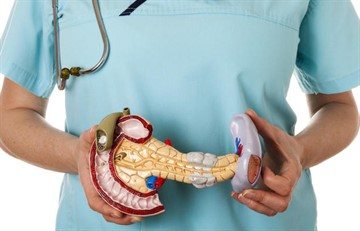
- liver function is impaired. Hereditary diseases play a significant role;
- a pancreatic tumor was discovered;
- there are pathologies of the vascular system;
- digestion is disturbed. There are diseases of the gastrointestinal tract;
- the child does not receive the necessary nutrition.
Most often, mothers talk about the baby’s congenital pathologies in the maternity hospital, after which they enter all the necessary information into the medical record.
If pathologies are detected, it is recommended to conduct an additional examination of the baby in the maternity hospital.
The influence of smoking and brushing teeth on indicators in the analysis

Smokers who are about to undergo a blood sugar test often ask how much smoking can affect the reliability of the indicators. Such patients should know that cigarettes have a negative effect on the entire body, including the biochemical processes occurring in it.
New information: Ketone bodies in urine: what it means and reasons
For this reason, we can say with confidence that smoking tobacco leads to distortion of the results. Therefore, patients are prohibited from smoking several hours before collecting material for research.
Smoking can have a significant impact on the health of patients with high glucose levels in the body. Tobacco smoke increases the load on cardiovascular activity and impairs blood circulation.
Considering the fact that the tests take place on an empty stomach, smoking is strictly prohibited before the procedure for collecting biomaterial. Smoking before meals can cause the patient to develop a whole range of unpleasant symptoms:
- dizziness;
- weakness throughout the body;
- the appearance of a feeling of nausea.
There is no reliable data on whether it is possible to brush your teeth before donating blood for analysis. Doctors can only assume that the components contained in the toothpaste can influence the accuracy of the results obtained. For this reason, most doctors who carry out laboratory research are of the opinion that it would be better to play it safe and not brush your teeth in the morning before submitting the biomaterial for examination.
Risk group
Some children are more likely to develop diabetes.
According to studies, the so-called risk group includes:
- newborns whose weight exceeded four and a half kilograms;
- children exposed to infectious and viral diseases. Weakened immunity contributes to the emergence of new ailments;
- genetic predisposition. There is a high chance of developing the disease in a child whose mother also has diabetes;
- unhealthy diet, consumption of potentially dangerous foods. In this case, it is recommended to avoid eating sweet and starchy foods, in particular pasta and bread.
It is advisable that the child eats a large amount of healthy food. One-year-old babies need to be fed breast milk, sugar-free baby food and a small amount of juices with pulp.
For older children, a large amount of vegetables and natural cereals cooked in water are recommended. As an alternative, you can introduce fruits into your diet.
Even if you give up sugar, it is not recommended to consume large amounts of natural juices and fruits. Excess fructose has a negative effect on the body.
Video on the topic
About the correct preparation for a blood sugar test in the video:
Parental awareness can save a child from unpleasant diseases in adulthood. This analysis must be taken several times to exclude the possibility of unpleasant illnesses.
DIAGEN® - innovation in the treatment of diabetes in humans
- Stabilizes sugar levels for a long time
- Restores insulin production by the pancreas
To learn more…



